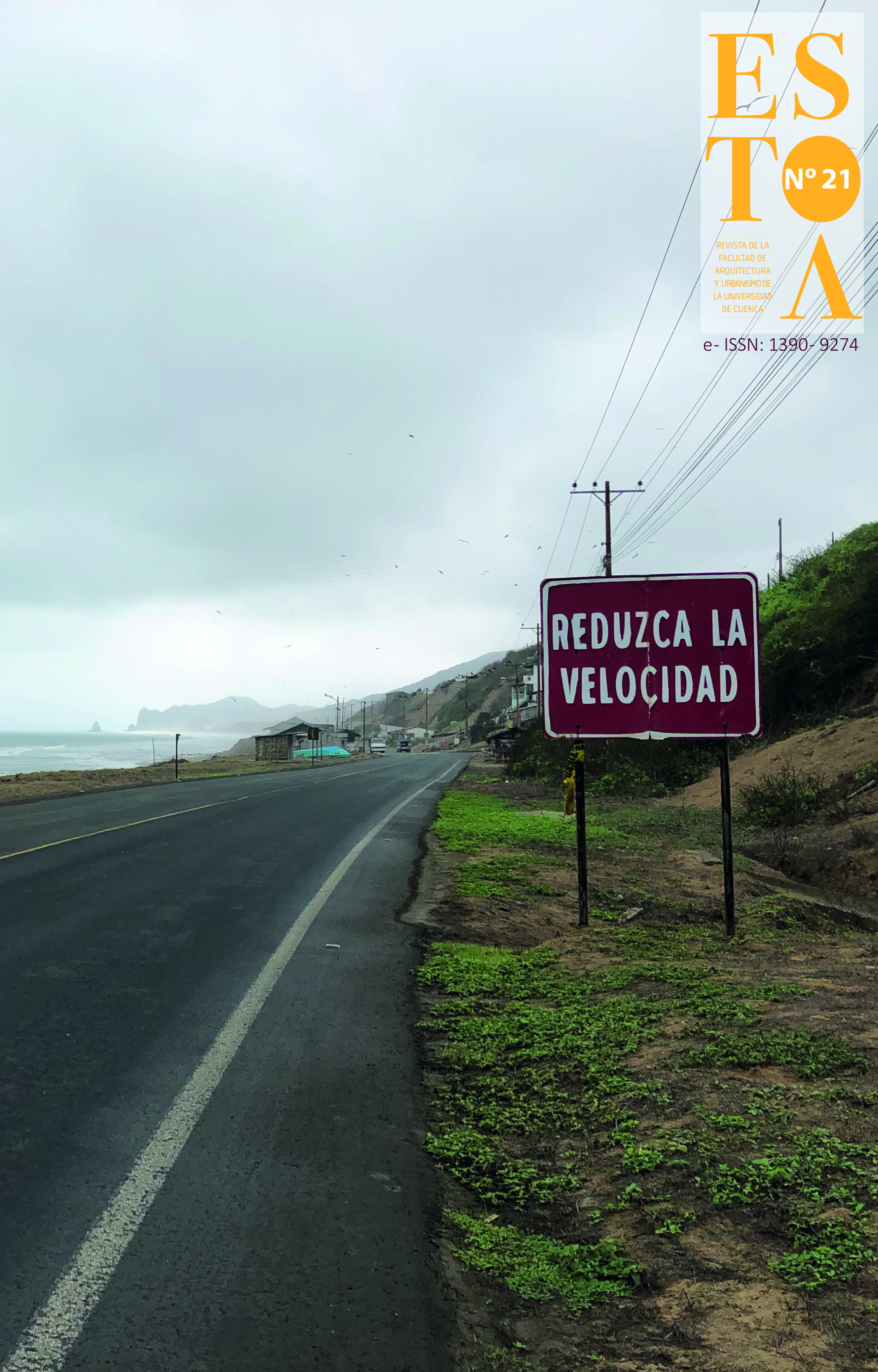The inrush of everyday life. The photographic narrative of a forgotten city
DOI:
https://doi.org/10.18537/est.v011.n021.a06Keywords:
Representations of the city, everyday space, documentary photography, Marcelo MontecinoAbstract
With the work of Chilean photographer Marcelo Montecino and his record of the Barrio Franklin neighbourhood as its starting point, this article discusses the ways in which a city and its transformation over time can be portrayed. Expanding the field of vision of urban representations, Montecino focuses on daily life: on the marks and imprints left by the community on the spaces it inhabits. Such actions are not judged as anomalies of the urban order but rather as evidence of a pattern of meaning that diversifies our reading of the city. Thus, through this photographic narrative of daily life, we recognise a forgotten city, a flawed one even, but one that is still fundamental to the processes of reconstruction of urban memory. It is the very relationship between representation, everyday space and memory construction that guides discussion in this study, conducted from a theoretical and critical perspective.
Downloads
References
Allen, S. (2009). Practice: Architecture, Technique + Representation. Routledge.
Aubán, M. (2017). La dignidad de los márgenes. Aproximaciones afectivas a la ciudad informal. Revista INVI, 32(91), 67-89. http://revistainvi.uchile.cl/index.php/INVI/article/ view/1223
Bou, E. (2015). Representing Everyday Life. Arizona Journal of Hispanic Cultural Studies, 19, 171-181. http:// www.jstor.org/stable/43855410
Bourdieu, P. (2003). Introducción. En P. Bourdieu, Un arte medio: ensayo sobre los usos sociales de la fotografía (pp. 37-50). Editorial Gustavo Gili.
Colin, C. (2017). La nostalgia en la producción urbana: La defensa de barrios en Santiago de Chile. Revista INVI, 32(91), 91-111. http://revistainvi.uchile.cl/index.php/INVI/article/ view/1216
Didi-Huberman, G. (2018). Cuando las imágenes tocan lo real. En G. Didi-Huberman, C. Chéroux y J. Arnaldo, Cuando las imágenes tocan lo real (pp. 7-36). Círculo de Bellas Artes.
Evans, R. (2011). Translations from drawing to building and other essays. Architectural Association.
Frizot, M. (2009). El imaginario fotográfico. Ediciones Ve.
González, P., e Ibarra, M. (2020). Cuando la periferia fue ciudad. Imaginarios y modernización urbana en el barrio Matadero (1902-1939). Revista Estudios Avanzados, 32(1), 74-93. https://doi.org/10.35588/rea.v1i32.4537
Goodman, N. (2010). Los lenguajes del arte: aproximación a la teoría de los símbolos. Espasa Libros.
Hall, S. (2013). The work of representation. En S. Hall, J. Evans y N. Sean (Eds.), Representation (pp. 1-47). The Open University, SAGE.
Heller, A. (2017). Everyday Life. Routledge.
Highmore, B. (2002). Everyday life and cultural theory: an introduction. Routledge.
Jiménez Chaves, V. E., y Comet Weiler, C. (2016). Los estudios de casos como enfoque metodológico. Academo. Revista de Investigación en Ciencias Sociales y Humanidades, 3(2). https://revistacientifica.uamericana.edu.py/ index.php/academo/article/view/54
Landa, I. (2020). Una aproximación a la historiografía urbana: algunos aspectos epistemológicos y metodológicos.
Revista EURE - Revista de Estudios Urbano Regionales, 46(139). https://www.eure.cl/index.php/eure/article/view/3183/1306
Lautréamont (2014). Obras completas. Argonauta.
Lindón, A. (2020). La periferia: fragmentos inestables de la ciudad vivida. Perspectiva Geográfica, 25(2), 15 - 33. https://doi.org/10.19053/01233769.10548
Martínez-Delgado, G. (2020). Derribar los muros. De la historia urbana a los estudios urbanos con perspectiva histórica: propuestas teóricas y metodológicas desde un diálogo interdisciplinar. Revista EURE - Revista de Estudios Urbano Regionales, 46(137). https://www.eure.cl/index.php/eure/article/view/2883/1243
Montecino, M. (2012). Marcelo Montecino. 50 Años. Pehuén.
Montecino, M. (2015). Santiago: invierno / verano. Ocholibros.
Montecino, M. (2015b). Walking around (Santiago). Pehuén.
Montecino, M. (2018). La máquina de coser y el paraguas: Franklin 1962-2018 / Marcelo Montecino. Ograma.
Olsen, C. S. (2016). Performing Urban Archives – a starting point for exploration. Cultural Geographies, 23(3), 511-515. https://doi.org/10.1177/1474474016638048
Santamaría Alzate, P., y Giraldo Vásquez, M. I. (2020). La ciudad como currículo y dispositivo formador. Propuesta de enseñanza del patrimonio cultural. Bitácora Urbano Territorial, 30(3), 71-82. https://doi.org/10.15446/bitacora.v30n3.79987
Sheringham, M., y Wentworth, R. (2016). City as archive: A dialogue between theory and practice. Cultural Geographies, 23(3), 517-523. https://doi. org/10.1177/1474474016646909
Simi, G. (2018). Ben Highmore: “The everyday is always a question, a problem”. MATRIZes, 12(2), 113-131. http:// dx.doi.org/10.11606/issn.1982-8160.v12i2p113-131
Solà-Morales, I. (2009). Terrain vague. En I. Ábalos (Ed.), Naturaleza y artificio. El ideal pintoresco en la arquitectura y el paisajismo contemporáneos (pp. 123-132). Editorial Gustavo Gili.
Sontag, S. (2006). En la caverna de Platón. En S. Sontag, Sobre la fotografía (pp. 13-44). Alfaguara.
Vila, W. (2014). La urbanización obrera en Santiago Sur, 1905-1925. De arrabal decimonónico a periferia proletaria [Tesis de Doctorado, Pontificia Universidad Católica de Chile]. https://repositorio.uc.cl/handle/11534/21369
Published
How to Cite
Issue
Section
License
Copyright (c) 2022 Estoa. Revista de la Facultad de Arquitectura y Urbanismo

This work is licensed under a Creative Commons Attribution-NonCommercial-ShareAlike 4.0 International License.
The Journal declines any responsibility for possible conflicts derived from the authorship of the works that are published in it.
The University of Cuenca in Ecuador conserves the patrimonial rights (copyright) of the published works and will favor the reuse of the same ones, these can be: copy, use, diffuse, transmit and expose publicly.
Unless otherwise indicated, all contents of the electronic edition are distributed under a Creative Commons Attribution-NonCommercial-ShareAlike 4.0 International License.




